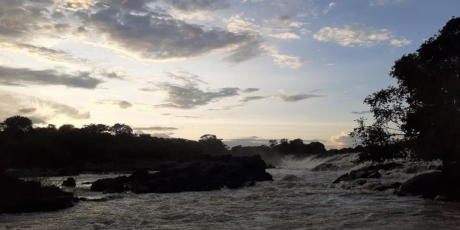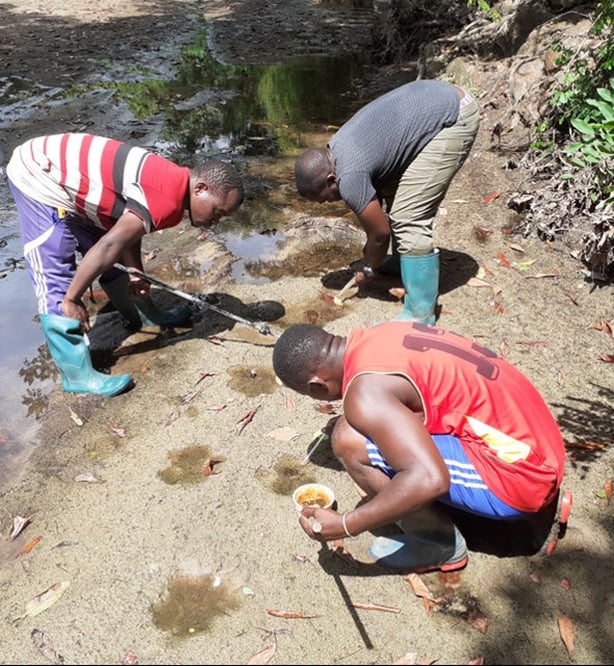Our search for the 'Adam and Eve of mosquitoes' in Tanzania 26 Mar 2024

Analysis: researchers need to find mosquitoes whose genetic heritage has been preserved intact in order to continue to combat malaria - Professor Gerry Killeen, AXA Research Chair in Applied Pathogen Ecology, School of Biological Earth and Environmental Sciences, ERI, UCC
What on earth am I doing here? I can't sleep, my bones ache to the marrow, my sweat slickens the plastic floor and the stifling heat within my Irish tent confirms it was not designed for Tanzanian weather. After a restless night, the sun comes up and I venture out to enjoy the stunning view of Shughuli Falls, where the mighty Ulanga River crashes through a series of rapids, creating a permanent rainbow and exceptional Tigerfish angling.
I stare in awe for as long as my fatigue allows me. Nyerere National Park is just my kind of place. About the size of two Irish provinces, it's utterly pristine, covered in beautiful miombo woodlands that hoover up carbon dioxide and as wild as one can imagine.
But I’m not enjoying myself. After struggling through breakfast, I realise I’m not getting too old for this kind of thing after all and I’m actually quite ill. After sweating it out in the shade for the rest of the day, my fever breaks in time for sunset and I remember again that I’m in paradise.
From UCC Science In Society, Prof Gerry Killeen on adventures with some of the world's most dangerous animals and pathogens
I also remember why I'm here in the Garden of Eden, wild Africa, exactly the way Mother Nature made her. My colleagues and I are searching for the Adam and Eve of malaria vectors, mosquitoes whose genetic heritage has been preserved intact here, untouched by the evolutionary selection pressures we humans create every time we use pesticides to protect ourselves, our animals or our crops. Only here, as far away from humanity as one can possibly get, might there be a chance that we can find mosquitoes whose ancestors were not decimated by wholesale pesticide use, leaving behind only descendants that can withstand these chemicals.
So why does that matter and why is it worth the cost, effort and risk involved in a project like this? The problem with living in the Garden of Eden is that the mosquitoes here have had a lot of time to learn how to exploit you, and that's why Africa bears 90% of the world's malaria-related disease burden.
Humans originate from Africa, so we have a much longer shared evolutionary history with animals on the continent, including four key mosquito species that have adapted to specialize on us as their preferred source of blood. Their hard-wired behavioural adaptations include feeding in the middle of the night, when most of us are asleep and defenseless, identifying us by smell from at least 80 meters away, and knowing how to sneak into our houses at night.
Their exceptionally strong preference for human blood often causes malaria transmission rates to exceed one exposure per person per day. As a result, most rural African communities were historically mired in a state of perpetual chronic malaria infection, while the acute form of the disease claimed more lives in the average year than all the wars and crimes on the planet.
Or at least it did before we learned to target those terrifying behavioural adaptations as an Achilles’ heel, allowing us to kill off populations of such human-dependent mosquitoes en masse. Insecticidal bednets work so miraculously well because sleeping under one protects you against the mosquitoes that try to attack you and also kills them before they can move on to your neighbours.
The determined roll out of insecticidal bednets across most of Africa over the last 15 years has reduced malaria transmission by over 90% in most places, accounting for most of the two billion malaria cases and 11 million malaria-related deaths averted in that time. Indeed, bednets have even eliminated the world’s most important vector from vast tracts of Africa, including that delightful corner of rural Tanzania where my wife and I thoroughly enjoyed raising our children.
From Latest Thoughts, the mechanisms of how mosquitoes transmit malaria
While all this unprecedented progress is now under threat as mosquitoes evolve tolerance to the insecticides that give bednets their magic, we can fight back. Bednets containing combinations of two or more quite different insecticides are now available, allowing us to change the rules of evolutionary game frequently enough to keep mosquitoes on the back foot.
But the ability of these new net products to combat insecticide resistance, and keep saving half a million lives a year, depends on the existence of a genetically diverse population of mosquitoes from which we can sift the vulnerability traits we need with astutely chosen insecticide combinations. That’s why I’m deep in the bush with my colleague Deo Kavishe, who has led our collaborative project at the Ifakara Health Institute in Tanzania with admirable resourcefulness, retrieving live mosquitoes from some stunningly remote corners of this extraordinary park.
In order to collect the Adam and Eve of mosquitoes, Deo has had to invent a self-cooling, self-humidifying backpack that keeps mosquitoes alive for up to a month of transport on foot through the toughest terrain. He has floated himself and his team over the otherwise impassable hippo-infested rapids of the swollen Ulanga River and taken them home again with their precious cargo of mosquitoes before the rains stalled and stranded them in the wild. He has swum across seasonal streams in full flood, holding his mosquitoes over his head, so he can get them back to the testing facility he built out of nothing in a forest at the centre of his 4000 square kilometer study area.

The news from those tests, relayed by satellite phone to our next survey location on the Ruaha River, is very good indeed. After searching in vain across towns and villages for over a decade, Deo has finally found wild mosquitoes that remain fully vulnerable to the insecticides we rely on to protect billions of people around the world against malaria.
We discuss this game-changing insight in a delightfully shady spot we now call our office. All he needs from me is a little help with telling his story in convincing scientific terms, so that all concerned can play the malaria vector control game to win. Despite the occasional discomforts, I think I have the best job in the world.